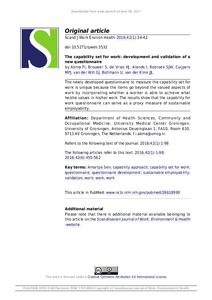The capability set for work: development and validation of a new questionnaire

Abma, Femke I. ; Brouwer, Sandra ; de Vries, Haitze J. ; Robroek, Suzan J.W. ; Cuijpers, Maarten P.J. ; van der Wilt, Gert Jan ; van der Klink, Jac J.L.
Scandinavian Journal of Work, Environment and Health
2016
42
1
34-42
employability ; measurement system ; questionnaire survey ; work capacity
Occupational qualification and job placement
http://dx.doi.org/10.5271/sjweh.3532
English
Bibliogr.
"Objectives
The aim of this study was to develop a questionnaire to measure work capabilities based on Amartya Sen's capability approach and evaluate its validity.
Methods
The development of the questionnaire was based on a combination of qualitative and quantitative methods: interviews, literature study, and an expert meeting. Additionally, in a survey, the validity was evaluated by means of hypotheses testing (using correlations and regression analyses).
Results
The questionnaire consists of a set of seven capability aspects for work. For each aspect, it is determined whether it is part of a worker's capability set, ie, when the aspect is considered valuable, is enabled in work, and is realized. The capability set was significantly correlated with work role functioning-flexibility demands (-0,187), work ability (-0.304), work performance (-0.282), worked hours (-0.073), sickness absence (yes/no) (0.098), and sickness absence days (0.105). The capability set and the overall capability item are significantly associated with all work outcomes (P<0.010).
Conclusions
The new capability set for work questionnaire appears to be a valid instrument to measure work capabilities. The questionnaire is unique because the items include the valued aspects of work and incorporate whether a worker is able to achieve what (s)he values in his/her work. The questionnaire can be used to evaluate the capability set of workers in organizations to identify aspects that need to be addressed in interventions."
Digital
The ETUI is co-funded by the European Union. Views and opinions expressed are however those of the author(s) only and do not necessarily reflect those of the European Union or the ETUI.